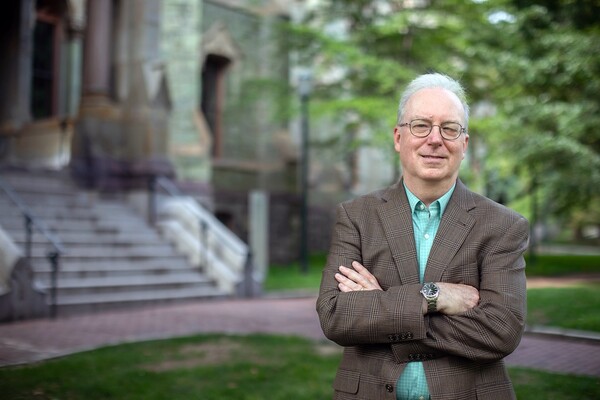
nocred
This summer, Leo Wagner, a rising junior in the College of Arts & Sciences majoring in urban studies from Rockville, Maryland, completed a summer internship with Historic Germantown. As part of Penn’s Summer Humanities Internship program (SHIP), Wagner conducted research on community responses to infrastructure projects in the mid-20th century and interviewed Germantown site directors to learn more about their use of green spaces.
Historic Germantown is a partnership of 18 independent historic and cultural sites in Northwest Philadelphia working to preserve the region’s unique historical assets. Established in the late 17th century, Germantown contains architectural assets that span centuries, including the place where the first American protest against slavery was drafted as well as one of the remaining locations of the Underground Railroad.
Like many other inner city American neighborhoods in the mid-20th century, Wagner says, Germantown was also shaped by urban renewal policies, including redlining and the restructuring of cities around the automobile. “City leaders wanted to ‘suburbanize’ the city, to bring back some of the residents that had left, and keep those neighborhoods vibrant, and a lot of that consisted of building urban highways and large cultural and civic centers,” he says.
But not all of the proposed urban renewal projects were finished, and this summer Wagner has been taking a closer look at several of those uncompleted infrastructure projects. His main focus was on a plan to bring more cars into Germantown by building a highway around the business district, an idea defeated by community opposition and activism.
“Because this bypass wasn’t built, that's part of why Germantown looks the way it does today, and it offers insight into urban renewal in general as well as the time period,” says Wagner. “It's interesting for me as someone who wants to go into urban planning because I think lessons learned from urban renewal brought about the way in which planning is done today, which is very participatory."
This summer, Wagner visited the Historic Germantown archives twice a week and worked with historian Alexander Bartlett to conduct archival research for an article to be published in the organization’s biannual magazine, the Germantown Crier. “I started by looking through the formal planning documents as to the timeline of how the plan evolved,” says Wagner. “Then, I looked through newspaper articles that were largely focused on various community organizations in Germantown and the strategies they took to oppose the bypass.”
While Wagner was disappointed to see how, in retrospect, many of the proposed suburbanization plans developed were “the antithesis of what makes a great urban neighborhood,” he was surprised at the level of community activism that was prevalent even in the early 2oth century. “This neighborhood had its own community newspaper, and it's clear that there seemed to be a very high level of civic engagement,” Wagner says.
Wagner also worked alongside Jenn Tham, programs and administrative coordinator of Hiatoric Germantown,to conduct interviews with site directors in the field. The work, says Historic Germantown’s executive director, Tuomi Forrest, is to learn how these green spaces are currently being used, with the ultimate goal of increasing community access and creating best practices the umbrella organization’s 18 member sites.
Building off community impact surveys conducted by previous SHIP interns, Forrest says this type of qualitative and quantitative data can help each site determine how to best make their facilities more inclusive use. “Universally, the sites are interested and active in engaging community members,” says Forrest. “We’re really looking to take that to the next level and do it in a way that’s partnership-driven and working with different community groups and neighborhood organizations to help do that.”
With Wagner’s interests in urban planning and affairs, he says that being able to work on a project deeply rooted in history and also connected to modern-day urban landscape use has been insightful. “It also links to thinking about what makes that space accessible and inviting to elements of urban history, and we learn from these mistakes by seeing a real-life example of urban renewal,” he says.
Forrest is “delighted” with the ongoing partnership with Penn, now four summers long, and with the students and projects that have come through the program. “It’s great to have Leo have the interest and flexibility to handle two really different types of projects and work that is also really important for us organizationally,” says Forrest.
Outside of his internship project, Wagner also enjoyed the opportunity to explore one of Philadelphia’s historic neighborhoods while thinking about the built environment. “It's important to look at these individual examples of resistance to urban renewal and how planning changed from a very top-down field in the 1950s to what it is today and understand that transformation has a lot to do with resistance to urban renewal,” Wagner says. “Looking at that history is important, especially in a site as unique as Germantown.”
Penn’s Summer Humanities Internship Program, coordinated through the Center for Undergraduate Research and Fellowships, provides a $4,500 award to students and is supported by the College of Arts & Sciences.
Erica K. Brockmeier

nocred

Image: fcafotodigital via Getty Images

Image: Mininyx Doodle via Getty Images

Charles Kane, Christopher H. Browne Distinguished Professor of Physics at Penn’s School of Arts & Sciences.
(Image: Brooke Sietinsons)